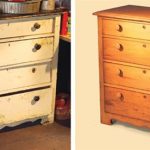We may receive a commission when you use our affiliate links. However, this does not impact our recommendations.
 In a perfect world (or shop), when you walk in to start on a project all your tools are in their proper place, the floor is swept and you can dive right in.
In a perfect world (or shop), when you walk in to start on a project all your tools are in their proper place, the floor is swept and you can dive right in.
In the real world (my garage shop, at least), the scraps from the last little project are scattered under my work planks and all the cordless drills, jigsaw, router and hand tools I used are lying all over the bench. They’re usually hidden by rags, bags and curls of plane shavings, and all the cords are tangled together, though I don’t have a clue how that could have happened.
Even worse, my Delta Unisaw has been hibernating under a sheet for the past six months (waiting for the next big project), with the 6″ jointer nestled up against it. I’ve started to take the sheet off a couple of times, but I know what I’m going to find: Work. An hour or two getting the mouse nursery out of the sawdust that I didn’t clean out of the base. And there’s a very good chance I’ll be touching up some surface rust on the top. My garage doesn’t offer air conditioned luxury, and it’s been a humid Summer.
Of course, that’s just the superficial part of getting the saw ready. Things get bumped and jostled over time, and I need to make sure the fence is true and accurate, and that my machinery is tuned-up and ready to make accurate cuts and joinery.
It’s smarter to do maintenance on a regular basis, but things slip away from you sometimes. I also know a few friends who’ve run into excellent “deals” at garage sales and in the newspaper. They bring home a tool that’s been unused for five or ten years, and it’s definitely a good idea to work through all the parts and settings on these “new” machines before running wood through them.
We’ve just added two DVDs to the Woodworker’s Bookshop to address just these maintenance issues. The first DVD in the Woodworking Machinery Basics Series is “Table Saws and Band Saws.” The second DVD focuses on “Jointers and Planers,” Beyond improving the general condition of the tool, we show you how to check and adjust tables flatness and accuracy, adjust and set the blades and knives and more.
If you’re ready for a refresher course on keeping your woodworking machinery ready to use at a moment’s notice, or if you’ve just added a slightly used tool to your collection, these DVDs have the info you need.
Here are some supplies and tools we find essential in our everyday work around the shop. We may receive a commission from sales referred by our links; however, we have carefully selected these products for their usefulness and quality.









Holy Hanta Virus! If there is any chance these little rodents might be deer mice, (and they could be…), just breathing in the dust left by their little droppings could set you up for something nasty enough (and works quickly enough) to end your career post-haste. (Hanta Virus has been discovered up into Canada and had been previously misdiagnosed as a different source of a nasty pulmonary ailment). Please spray those droppings down with bleach first, let it all dry out, and then clean it up. (Or you could do the Bill Clinton thing and just not "inhale"…). Your family may thank you!
My brother-in-law, who worked as the master carpenter when I was building my house, used to tell a story of when he first started teaching at a school for the deaf. His first class was an advanced class, so after briefly meeting with the students he sent them to their machines to begin a project. When the students turned on their machines, there was a terrible deafening (to him!)screeching that his students didn’t hear. He spent the rest of that class teaching about machine maintenance.